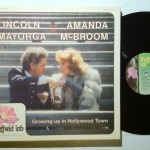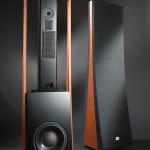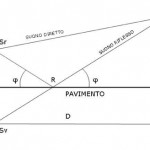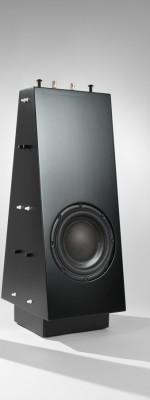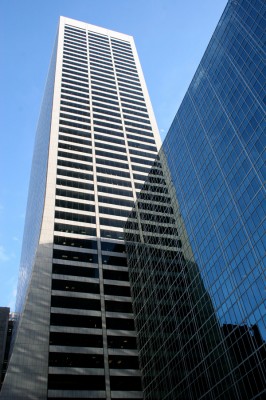Delta 4
The Delta 4 design philosophy
The hypothesis placed at the base of any GR Delta 4 design ever consists in the will to provide a riliable, unambiguous result in any environmental situation.
It is therefore very important that no listening feeling can born by the elements which effect is not adequately foreseen, dimensioned and verified either during the phase of the theoretical study as in the realization of the prototypes.
For Giussani Research, the primary target of its projects is to ensure a reproduction as respectful as possible of the characteristics of the original acoustic signal, recorded by the microphones used by sound engineers who have from time to time made available in various formats their recordings.
When one of these technicians, that is famous worldwide for the quality of his recordings (the founder of Sheffield Lab, Doug Sax), heard one of his best
recordings through two speakers designed by Renato Giussani decided to send to the well known american magazine The Abso!ute Sound a letter in which he declared that those speakers where the best he had ever heard and claimed to have been able to hear those speakers (ESB 7/06) propose the same sound, both of his piano played by Lincoln Mayorga as the voice of singer Amanda Mc Broom he had listened live while making personally the recording . That record belongs to the famous series of Sheffield vinyl Direct to Disc and its title is “Growing Up in Hollywood Town”.
So we’re not talking either general trend of the frequency response nor special effects, but that from a purely technical point of view it would be a good thing to provide for every project of hi-end speakers a faithful reproduction as natural as possible.
The sensitivity
Whether it’s a rock concert rather than a chamber ensemble, a symphony orchestra, a jazz band or just a piano and a singer, the acoustic characteristics of the room where we would hear them live are likely to be very different from those of the listening room of a private house.
To listen to music with pleasant and rewarding feeling of being in conditions very similar to “live” the maximum peak level that we should be able to reach in our listening position (but possibly not to exceed) is about 113 dB SPL.
With high dynamic recordings this corresponds to an average level with music of about 83 dB, similar to that achieved by a chamber ensemble in a small auditorium, for example.
Of course, starting from the same peak level, the average signal level may also be higher than 83 dB if the signal that we are playing is characterized by a crest factor less than 20 dB (113-83).
In order to achieve the 113 dB peak at a distance of 2.5 m in a normal home environment with an area of 20 square meters and a height of 2.8 meters characterized by an average reverberation time of 0.7 s, with speakers with a sensitivity of 87 dB / W / m you will have to use an amplifier capable of about 94 watts RMS into 8 ohms per channel.
Of course if the signal being played has’nt a crest factor as high as 20 dB, but is characterized by the most frequent value of about 17 dB or less, the maximum power required would drop to half or less: about 45 watts. If listening happens at a shorter distance, such as 2 meters, the power required would drop even further, to about 35 watts.
If instead the available room has a surface of 70 sq m for 3 m high (ie a volume of 210 cubic meters) and more absorbent than average, standing 4 meters away from the speakers to listen at an appropriate level with the same 87 dB / W / m systems we would need an amplifier of at least 450 watts RMS into 8 ohms per channel.
Power that naturally the speakers must be able to withstand.
Filed therefore the first technical number, ie a sensitivity of about 87 dB / W / m, we now will see the technical reasons that underlie the particular positioning of the various transducers on the Delta 4.systems.
The woofer‘s position
One of the primary choices in the design of Delta 4 speakers is to put their woofers at a minimum distance from the floor to obtain that the reflection from the floor itself will not cause sound damage with his interference.
Let’s now take the data of one of the Delta Series models to do some calculation and two other considerations relating to the position of the woofer that can quite easily clarify what has just been stated.
With reference to the figure on the left we can calculate for which frequency the direct sound and the reflected one, from the image woofer under the floor, would interfere when reaching the ears of an hypothetical listener causing a strong narrow band attenuation in the frequency response of the speaker.
The reflection from the floor of the emission of a speaker can be considered to be emitted by its image source, located under the floor itself.
For a distance D = 2.5 m, a woofer’s high HS = 50 cm and a ears high HP = 110 cm, using the Pythagorean theorem, we can calculate that the direct path lenght is:
SRP = SQR [D ^ 2 + (HP-HS) ^ 2] = SQR [2.5 ^ 2 + (1,1-0,5) ^ 2] = 2.571 m
Bearing in mind that the reflected sound from the floor can be considered emitted by the source image of the speaker that is located under the floor, and that
HSV = HS
the reflected path will be:
SVP = SQR [D ^ 2 + (HP + HSV) ^ 2] = SQR [2.5 ^ 2 + (1.1 +0.5) ^ 2] = 2.968 m
and the difference between the two paths will therefore be:
Δ = 2.968 to 2.571 = 0.397 m
that corresponds to half a wavelength of a sound at 433 Hz, the frequency at which a listener whose ears shouls be placed in P would perceive an attenuation in the frequency response, if the woofer response should be extended beyond this frequency,
Coming to our Delta 4 R9, since in this model the low-pass frequency of its woofer is placed at about 320 Hz, wanting to avoid any problem is well that any interference with the reflection from the floor occurs at higher frequencies.
In fact, the woofer of this system is placed much closer to the floor, exactly at a height of 26 cm that, for the same listening conditions already seen, should lead to an attenuation in the frequency response at 824 Hz, while as we have already seen the crossover frequency with the midrange is placed as low as 320 Hz, canceling any possibility that any problem could arise.
In the case of the Delta 4 R10 model, that employs two woofers, the end of the frequency band emitted by the highest woofer is still low enough to not cause any problem at all.
But the advantages of the proximity of the woofer of a multi-way system to the floor certainly did not end here.
Another positive effect is the increase of the woofer level audible from the listening position.
This increase, which in the Delta 4 configuration applies both to direct and reverberant field, is across the whole band emitted by the woofer and indoors reachs about 2 dB.
Since the woofer, in any multi-way designed system, is the less sensitive transducer among all those employed, an increase of the emission of this speaker automatically translates into the possibility to design a system whose sensitivity is 2 dB higher compared to that of an identical system whose woofer is placed away from the floor.
Another non-negligible advantage that descends from having the woofer very near the floor is the greater insensitivity of the system to variations in the characteristics of the environment in which it is installed.
In any domestic room chosen for an hi-fi reproduction it’s very unlikely that the horizontal size of the room is less than or equal to its height.
This fact entails the immediate consequence that in all listening environments the two surfaces having the largest area are the ceiling and the floor.
These surfaces, especially in modern buildings with concrete structure, are also the most rigid and most heavy per square meter.
In addition, among the two, we are accustomed to live much closer to the floor. This means that the floor surface becomes the most important for our listening sessions, being acoustically able to intercept and reflect the greatest number of acoustic waves emitted into the environment, especially if issued in its vicinity as we have seen is the case of Delta 4 speakers.
And the “working” of the floor will ever be very similar in different environments too, guaranteeing the placing by the woofer of the same acoustic power into the environment.
We shall soon see how combining this condition to the one that medium and high frequencies are so little affected by ambient acoustics may provide an unmatched versatility, that can provide the same high quality sound in any different environment.
The issue of the midrange
As in the case of the woofer, the output of the midrange (at least on the lower part of the range that this component is normally called to reproduce) is quite large in both horizontal and vertical planes.
As regards the horizontal dispersion, it must be not excessive, given that a strong lateral emission could lead to unpleasant reflections on the side walls that were occasionally too close to the speaker.
In the Delta 4 configuration the lateral emission is reduced thanks to a load panel of midrange with extremely contained horizontal dimension that, in addition to reducing the emission level towards the side walls, obtains also many other advantages that we’ll go immediately to clarify.
First of all, a polar diagram that privileges the frontal emission inable orienting the system as required by the GR NPS horizontal technique, which helps to substantially reduce either perspective as timbre distorsion consequent to a not perfectly centered listening position.
In addition, a mid-high section whose width is well below 20 cm also gets not to perceive the diffraction at the edges of the panel, making it acoustically invisible and allowing to correctly perceive all the best possible informations on the size of the real instruments whose sound has been properly recorded.
But, the reduced horizontal size of the mid-high section also at least obtains two other particularly important effects.
The first one consists in the fact that acoustic waves that the speaker emits toward the rear wall, when reflected towards the listener will be able to reach it without encountering any acoustic obstacle in their path (i.e.the speaker itself), able to block them. And this, in the case of speakers Delta 4, is real up to 1,000 Hz
This condition is extremely similar to that offered by electrostatic loudspeakers which, thanks to the lightness of their membrane, let pass almost unhindered the reflection from the rear wall, resulting in a further increase in the feeling of physical absence of the system and therefore allowing to perceive much better the original information about the physical presence of the recorded instruments.
The second effect due to the small horizontal mid-high section size consists in the fact that, starting from the crossover frequency with the woofer and at frequencies gradually increasing up to a limit of approximately 1,000 Hz (that is the entire range more involved in the creation of an important reverberated field) the dispersion of the midrange is very similar to that of woofer (nearly omnidirectional) making the listening to these two components extremely homogeneous and the acoustic image very consistent despite the considerable distance that separates them. Distance that is used to obtain three other important acoustic conditions.
The first one is of the same type as already seen for the distance from the floor of the woofer, but acting in a specular way.
Since in all GR Delta 4 models the midrange is placed at 110 cm from the ground, with reference to same figure already seen, for it we can write:
Direct path SRP = SQR [2.5 ^ 2 + (1,1-1,1) ^ 2] = 2.5 m
Path reflection SVP = SQR [2.5 ^ 2 + (1.1 +1.1) ^ 2] = 3.3 m
and the difference between the two paths will therefore be
Δ = 3.3 to 2.5 = 0.8 m
Corresponding to half a wavelength of a sound at 215 Hz, frequency that no midrange of any Delta 4 emits and in correspondence of which can’t therefore ever occur any cancellation due to the reflection from the floor.
Other two effects attributable to the 110 cm height of the midrange are those related to the perception of an average height of the acoustic scene lieing exactly in front of the listener, and to a different vertical dimension for each instruments reproduced, that will be more and more wider as the sound of the instruments is characterized by a frequency spectrum that encompasses both mid-range emitted by the medium-low speaker and low-range issued by the woofer.
The related effect will be to perceive, for example, a cello bigger than a violin, recreating the natural situation, in which to emit consistently frequencies gradually more and more lower are acoustic instruments characterized by a gradually increasing size.
The system structure
The main aspect regarding the function of the furniture which support the transducers of a loudspeaker system regards first its size, but the materials employed and the shape adopted aren’t less important.
The volume for the acoustic load of the woofer is chosen primarily in relation to the choosen type of operation, that must be the more suitable for the technical philosophy of the whole Delta project.
Where one of the main aspects of this philosophy is constituted by the absence of sound tails generated from the speaker itself. To better accomplish this condition the preferable type of load is always the easiest, in this case the acoustic suspension.
This woofer working makes it possible to completely avoid the birth of any spurious noise and the possibility to use of a good amount of absorbent fiber able to achieve maximum damping of rear emission of the speaker that occurs within the volume of the load, avoiding any possible internal rumble.
To this condition, very positive itself, the Delta 4 systems add a non-parallelepiped shape of the woofer loading volume, totally excluding the possibility of the birth of resonances and standing waves (in the panels themselves too).
Finally, the attenuation of the frequency response at the lower end of the woofer working in the sealed box has a bland rate of 12 dB/octave and the resulting acoustic phase shift is small, contributing to make listening of the reproduced sounds more like the natural ones of the real recorded instruments but obtaining also a total absence of the localized resonance feeling ever associated with a sharp low-end limitation.
Coming to the material used, it’s well known to any designer that it should be as heavy as possible, compatibly with its damping characteristics.
Furniture made of steel, glass or marble, for example, certainly do’nt represent the best solution, unless the resonances of their own panels were not adequately damped by the application of bituminous layers or similar materials able to dissipate the considerable energy always associated to the vibrations of heavy panels.
For the Delta Butterfly One cabinet, for example, the employed damping material is an thick lead layer. Characterized either by a high weight as an high plasticity and therefore such as to optimally isolate the sound emitted inside the cabinet (already widely insulated) from the outside world.
The protective grilles
Seen the more important aspects concerning the design philosophy of the Delta 4 systems, we would draw now your attention to the importance of the cover panels of the technical structure of the speakers, whose acoustic most important property must be to affect as little as possible the characteristics of the sound that passes through them.
In addition to having a clear protective role against UV rays, dust (which other types of coverage cannot guarantee) and the attentions of too curious listeners, the grilles of the Delta 4 have also the function of aesthetic completion of the furniture themselves.
This feature was initially enhanced, in the first Delta 4 designed for Audiolab, by the shape inspired to the TMA-1 monolith from the movie “2001: A Space Odyssey”, and more recently (designing the newest version of Delta 4 Giussani Research), by the decision to relay for their shape to that of the Grace Building (famous Manhattan skyscraper).
But in addition to the above, the protective grilles also play an important psychoacoustic role: to obscure the view of the transducer and allow the natural birth of a perception of the acoustic scene and its sources released by the visual sensations and vice versa more closely related to original acoustic information present in the reproduced signal. Information that with GR Delta 4 speakers assume, as we have seen, a crucial importance for achieving maximally realistic listening conditions, natural and respectful of the characteristics of the recorded signal.


